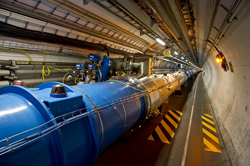Over 140 digitizer cards from Spectrum Instrumentation are being used in the machine protection systems of the Large Hadron Collider (LHC) at CERN. The cards are used to check that the particle beams have been accurately deflected. Incredible precision is required for this as two high-energy particle beams travel at close to the speed of light in opposite directions in the 27 km LHC accelerator ring. They are then made to collide at four locations around the ring for runs of several hours. The particles are so tiny that the task of making them collide is akin to firing two needles 10 kilometers apart with such precision that they meet halfway.
The energy stored in the two beams is so high that, in the case of loss of control of the beams, the LHC machine could suffer serious damage. To safely dispose of the beams in the case of an emergency, or at the end of a collision run, the LHC Beam Dumping System (LBDS) must extract the full beams from LHC in one revolution and transport them to an absorber block located about 700m away from the LHC rings. After every beam dump, post-operation check systems will make sure that all elements within LBDS performed correctly and that the beams were cleanly extracted.
A key part is checking that the fast-pulsed magnets, called kicker magnets, have accurately deflected the particle beams from the LHC rings to the extraction lines. Digitizer cards are used to capture the current pulse waveforms to check that they had the correct shape and were correctly synchronized with the beam. To give an idea, the LBDS extraction magnet current pulses themselves are about 20 kA with rise times of less than 3 µs and a synchronization error below 20 ns. At LBDS alone, for every beam dump event, nearly 500 analog signals are acquired using digitizer cards and more than 150 synchronization signals are captured using digital I/O cards.
“We have developed our own waveform acquisition and analysis framework called IPOC (Internal Post Operation Check),” explained Nicolas Magnin, Software Team Leader for the Accelerator Beam Transfer group at CERN. “It is programmed using C++ on Linux and it includes a hardware abstraction layer that enables us to interface with many types of digitizer cards. We use a variety of digitizer cards from Spectrum Instrumentation to cover a range of kicker magnets used for all the CERN accelerators that have different requirements in terms of bandwidth and dynamics. This variety of cards enables us to cover a bandwidth range from 10 MS/s to 500 MS/s and a resolution from 8 to 16 bits depending on the application.”
A very high level of precision is naturally required for the measurements of these kicker pulse events. For example, the most demanding systems require a pulse-to-pulse reproducibility error for the delay of lower than 10 ns, and for the amplitude of lower than 0.5% within a dynamic range of 16. To achieve this, the precision of the acquisition has to be even greater by an order of magnitude, hence the choice, for instance, of a Spectrum Instrumentation M4i.4451-x8 digitizer with a time resolution of 2 ns and an Effective Number Of Bits (ENOB) larger than 10. As the kicker current signal dynamic is not fixed, the various input ranges of the digitizer are used to optimize the signal-to-noise ratio of the acquired waveform. Almost all waveforms are saved in a logging database for later offline analysis. Also, all waveform analysis results (for instance: delay, length, rise time, fall time, flat top amplitude, etc.) are stored in the logging database to extract trends over time to check system stability, temperature dependency, etc.
“We chose Spectrum Instrumentation products because they provide excellent quality at a very competitive price,” added Nicolas Magnin. “They are very simple to set up with user-friendly software tools, and the driver sources are easy to compile and deploy on our Linux operational environment. I particularly appreciate the documentation and coding examples that are provided, which make it easy to get started. We have bought a number of Spectrum Instrumentation cards over the past eight years with only a couple of issues with out-of-warranty cards that Spectrum Instrumentation repaired and returned very quickly. Similarly, their support was very quick with answers to our questions during the development phases.”
“We also make use of Spectrum Instrumentation Arbitrary Waveform Generator (AWG) cards to simulate kicker current waveforms and Spectrum Instrumentation Digital Pattern Generators cards to send timing and control signals to help to develop and validate surveillance and protection systems on our test benches. We sometimes also use LabVIEW on Windows for test benches, as Spectrum Instrumentation hardware is directly compatible with this environment.”
More than 140 Spectrum Instrumentation cards are presently used in operation for kicker systems on all CERN accelerators, on PCI/PCIe and more recently, PXIe platforms.
“CERN’s use of our digitizer cards is a typical example of our customers,” said Gisela Hassler, Spectrum’s CEO. “Major research institutions, universities and multinational R&D departments choose our products because of their quality. Their projects often run over many years so they want equipment that they can rely on for these long periods. We have many products still in active use that are over ten years old. This is also why we introduced our five years warranty to provide peace of mind for people designing and running experiments over a number of years.”


